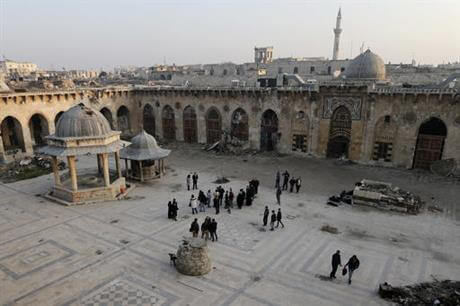
By BASSEM MROUE
The Great Mosque of Aleppo, a centuries-old treasure at the heart of one of the world’s oldest cities, is today a grim testament to the ravages of Syria’s war.
The doors have been blasted away, the walls have been shredded by gunfire and shrapnel, and the minaret where the Muslim call to prayer sounded for 900 years has been toppled and shattered. The wooden pulpit, along with ancient manuscripts from a nearby library, has been carted off by looters.
Syrians are only now able to survey the damage wrought by more than four years of war. Rebels from the countryside poured into Aleppo in the summer of 2012, capturing eastern districts and transforming the Old City into the front lines of a war of attrition with forces loyal to President Bashar Assad.
The rebels surrendered last month after a massive government offensive and were evacuated to other areas, allowing Assad to regain control of the country’s largest city.
The red carpets inside the mosque are covered in debris, while damaged copper chandeliers are still hanging from the ceiling. An extensive network of sandbags used by the rebels snakes throughout the compound.
Also known as the Umayyad Mosque, the site was reopened in 2006 after a 20-year renovation project. Aleppo’s Old City, a UNESCO world heritage site, also boasts a 13th century citadel, a sprawling bazaar and several other monuments, nearly all of which have been damaged or destroyed.
Before the rebels stormed the city, the state built a cement wall to secure a tomb inside the mosque believed to hold the remains of the Prophet Zakariah. But an ornate wooden pulpit modeled on the one inside Jerusalem’s Al-Aqsa Mosque was pillaged.
Sheikh Abdul-Qader Shehabi, a senior Muslim cleric who spent years studying and working in the Umayyad Mosque, said 70,000 books were stolen from a nearby library, including copy of the Quran transcribed in the Middle Ages, which he says was smuggled out and sold in Turkey for $250,000.
Khaled al-Masri, director of museums and antiquities in Aleppo, downplayed the extent of the destruction, saying the mosque could be repaired within a year and the minaret could be rebuilt in three. “The damage is simple and we can return the Umayyad Mosque to how it was,” he said.
But the war is still raging elsewhere in the country, and even if the cash-strapped government prevails it will confront a massive reconstruction challenge , not only in Aleppo but in other cities and towns.
“This mosque used to be a jewel,” said Fateh Abdullah Nahhal, a grocer who brought his children to the site for the first time in five years. “All we can say is for God to help us punish those who did this.”



